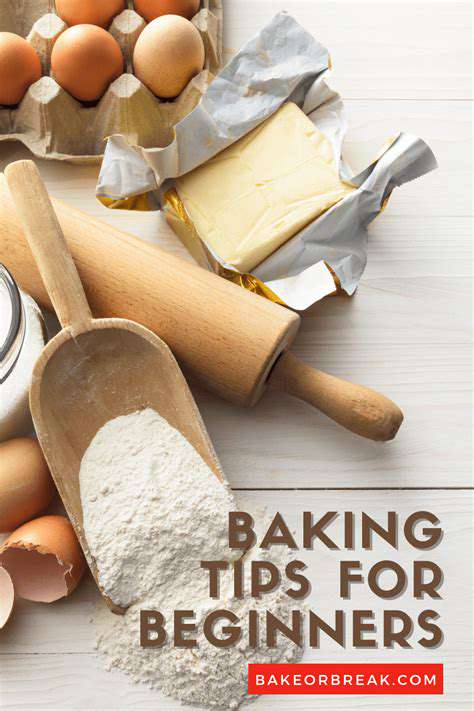Baking Tips and Tricks: Achieve Perfection
When measuring dry ingredients like flour, sugar, and cocoa powder, using a properly calibrated kitchen scale is often the most accurate method. Simply scooping ingredients directly from the bag or container into measuring cups can lead to significant inaccuracies due to packing density. A scale ensures every gram is accounted for, guaranteeing consistent outcomes.
For those without a scale, using measuring cups and spoons is still an option. However, it's vital to level off the ingredients with a straight edge to remove excess. This prevents overmeasurement, which can result in a dense or dry final product.
Liquid Ingredients: Accuracy is Key
Liquid ingredients, such as milk, eggs, and oil, also require careful measurement. Using a liquid measuring cup and ensuring the measurement is at eye level is essential. Incorrect measurements can affect the moisture content of the baked goods, impacting their texture and overall success. A slight variation in liquid measurement can result in a cake that's too dry or a cookie that's too chewy.
The Role of Temperature in Ingredient Measurement
Temperature plays a subtle but important role in ingredient measurement, particularly for liquids. Room temperature ingredients often perform better in recipes, aiding in proper mixing and creating optimal textures. For instance, eggs at room temperature will incorporate more easily into batter, leading to a more tender finished product.
Understanding Ingredient Substitutions
While precise measurements are key, understanding ingredient substitutions can be a valuable skill for bakers. Knowing how different ingredients react and how to adjust recipes accordingly allows for flexibility and creativity in the kitchen. For example, substituting all-purpose flour with whole wheat flour necessitates a slight adjustment of other ingredients to maintain the desired outcome.
Beyond Basic Measurements: Using a Scale
Investing in a kitchen scale is a significant step towards mastering accurate ingredient measurement. A scale provides unparalleled precision in measuring both dry and liquid ingredients, allowing bakers to achieve consistent results across different recipes. This precision is invaluable in creating professional-quality baked goods, whether you're a novice or an experienced baker.
Troubleshooting Measurement Issues
Even with the best tools and techniques, measurement errors can occur. If you're experiencing issues with your baked goods, checking your measurements is often the first step in troubleshooting. Understanding the potential impact of slight variations in ingredients can help you pinpoint the source of a problem and adjust future recipes accordingly, ultimately leading to more successful baking endeavors.
Baking Techniques for Consistent Results

Understanding the Fundamentals of Baking
Baking, at its core, is a science as much as it is an art. Mastering fundamental techniques like understanding different types of flour, the importance of precise ingredient measurements, and the impact of oven temperatures is crucial for achieving consistent results. A thorough understanding of these fundamentals will dramatically improve your baking outcomes and allow you to confidently experiment with new recipes. Knowing how different ingredients interact with each other, from the leavening agents to the liquids, is essential to predicting the final product's texture and structure.
Consistent baking requires precision in your measurements. A tiny deviation in the amount of sugar, flour, or baking powder can significantly alter the final outcome. Using accurate measuring tools and methods, like weighing ingredients, is vital for achieving consistent results. This precision, coupled with understanding the science behind each step, will lead to more reliable and enjoyable baking experiences.
Temperature Control and its Significance
Temperature is paramount in baking. Different ovens vary in their heating patterns, so understanding how your oven behaves is essential for achieving consistent results. Using an oven thermometer to verify the actual temperature and adjusting your baking times accordingly is crucial for preventing undercooked or overcooked products. This careful monitoring ensures that each batch is cooked to perfection.
Precise oven temperature control is often the difference between a perfectly risen loaf of bread and a dense, heavy one. Maintaining a stable temperature throughout the baking process is key to achieving a consistent texture and achieving a desired outcome. Understanding how different ingredients react to heat, and adjusting your baking time accordingly, is a key factor in successful baking.
Mixing Methods and Their Impact
Mixing techniques significantly impact the final product's texture and structure. Understanding the appropriate mixing method for each recipe is vital. For example, overmixing can lead to tough or gummy baked goods, while undermixing can result in unevenly distributed ingredients. Careful attention to mixing techniques can greatly enhance the quality of your baked goods. This attention to detail is critical to ensuring the consistency of your results.
The incorporation of air into the batter or dough, achieved through proper mixing, is essential to achieving a light and airy final product. Different mixing methods optimize the incorporation of air, affecting the final volume and texture. Understanding these techniques and adapting them to specific recipes will greatly increase your ability to create consistent and delicious baked goods.
Muscle tension and strain can lead to pain in the back of the head.
Troubleshooting Common Baking Problems

Understanding Oven Temperature Fluctuations
Oven temperature fluctuations can significantly impact baking results. A consistently inaccurate oven temperature can lead to underbaked or overbaked goods. Factors like the age of the oven, its location, and even the type of cookware used can contribute to these inconsistencies. Understanding how your specific oven behaves is crucial for achieving reliable baking outcomes.
Regular oven thermometer checks are essential. These checks help identify any discrepancies between the set temperature and the actual temperature inside the oven. Using an oven thermometer placed inside the oven during baking provides precise readings and ensures that your baking process is on track.
Evaluating Ingredients' Quality
The quality of ingredients plays a vital role in the success of any baking endeavor. Using fresh, high-quality ingredients like eggs, flour, and butter directly impacts the texture, flavor, and overall outcome of your baked goods. Stale ingredients can lead to dry or crumbly results. Pay close attention to expiration dates and the appearance and smell of your ingredients before using them in your recipes.
Ensure that your ingredients are at room temperature for optimal results. Cold ingredients can affect the mixing process and the final product's texture.
Analyzing Baking Time and Temperature
Baking times and temperatures are crucial elements in achieving perfectly baked goods. Adjusting baking times and temperatures based on your oven's specific characteristics is essential for consistent results. Recipes often provide a starting point, but some adjustments might be necessary. For example, different altitudes and oven models can affect baking times.
Precisely following the recipe's instructions is key. Variations in ingredients, oven types, and altitudes can significantly alter the required baking time. Experimentation and notes on baking times are beneficial for future reference and improvements.
Checking for Proper Mixing Techniques
Proper mixing techniques are fundamental for achieving a well-structured batter or dough. Incorrect mixing can lead to unevenly distributed ingredients, resulting in a less desirable texture and overall appearance of the baked product. Different ingredients require different mixing methods. Carefully follow the recipe's instructions for optimal results.
For example, overmixing can develop gluten in the dough, leading to a tough final product. Conversely, undermixing can result in a sticky or unevenly distributed batter.
Troubleshooting Issues with Leavening Agents
Leavening agents, like baking soda and powder, are essential for baked goods' rise and volume. Problems with leavening agents can lead to flat or dense baked goods. Ensure that leavening agents are fresh and properly incorporated into the batter. Incorrect measurements or storage conditions can affect their effectiveness.
Pay close attention to the expiration dates of leavening agents, and store them properly to maintain their potency. Using fresh leavening agents is essential for achieving a light and airy texture.
Addressing Issues with Dough or Batter
Understanding the properties of dough or batter is crucial for successful baking. Problems with the dough's consistency or the batter's texture can significantly affect the final product. The ingredients' ratios, mixing techniques, and resting periods all contribute to the desired outcome. Consider using a stand mixer for large batches or recipes requiring thorough mixing.
Adjusting the dough or batter's consistency with liquid, if necessary, is essential. Overmixing can result in a tough product, and undermixing can lead to incomplete rising.
Examining the Cooling Process
Allowing baked goods to cool properly is often overlooked but is crucial for achieving the best texture and flavor. Rapid cooling can lead to a dense or tough product. Proper cooling allows the baked goods to firm up, preventing sogginess and maintaining their shape. Allowing baked goods to cool completely on a wire rack is generally recommended.
Avoid placing warm baked goods directly on a cold surface. Cooling slowly and evenly is important to prevent uneven cooling and potential shrinkage.